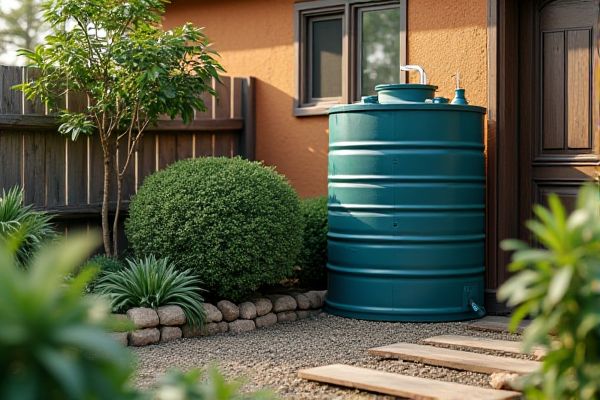
Rainwater barrels collect and store runoff from rooftops, providing a convenient source of water primarily for small-scale garden irrigation, while irrigation tanks are larger systems designed for efficient distribution of water across extensive agricultural areas. Understanding the differences between these water storage solutions can help you choose the best option for your landscaping or farming needs; discover more about their advantages and applications in the rest of the article.
Table of Comparison
| Feature | Rainwater Barrel | Irrigation Tank |
|---|---|---|
| Primary Use | Collects and stores rainwater for general outdoor use | Stores water specifically for irrigation systems |
| Capacity | Typically 50-250 gallons | Ranges from 500 to several thousand gallons |
| Material | Plastic, metal, or wood | Plastic, fiberglass, or concrete |
| Installation | Simple, usually placed under downspouts | Requires professional installation and plumbing |
| Water Quality | Untreated rainwater, suitable for plants but not potable | Can include filtration and treatment for safe irrigation |
| Cost | Low ($50-$200) | Higher ($500 and up) |
| Maintenance | Periodic cleaning to avoid debris buildup | Regular system checks and cleaning required |
| Environmental Impact | Helps reduce stormwater runoff and conserve water | Efficient water usage for large-scale irrigation |
Introduction: Comparing Rainwater Barrels and Irrigation Tanks
Rainwater barrels and irrigation tanks both collect and store water, but rainwater barrels typically hold smaller volumes ideal for residential use, while irrigation tanks offer larger capacities suitable for agricultural or extensive garden watering. Your choice depends on water needs, space availability, and intended application, with rainwater barrels providing portability and simplicity, and irrigation tanks delivering higher efficiency and automation potential. Understanding these differences helps optimize water conservation and garden health effectively.
Key Differences Between Rainwater Barrels and Irrigation Tanks
Rainwater barrels typically collect and store rainwater from rooftops for small-scale garden use, offering a portable and cost-effective solution. Irrigation tanks, on the other hand, are larger, often underground or freestanding systems designed to supply consistent water pressure for extensive agricultural or landscape irrigation. Your choice depends on the scale of water storage needed and the intended application, with barrels suited for residential use and tanks optimized for commercial or large-scale irrigation systems.
Capacity and Storage: Which Holds More Water?
Rainwater barrels typically have a capacity ranging from 50 to 100 gallons, making them suitable for small-scale water collection and gardening needs. Irrigation tanks, on the other hand, offer much larger storage capacities, often exceeding 500 gallons and sometimes reaching several thousand gallons, designed to meet extensive agricultural water demands. The significant difference in capacity allows irrigation tanks to store considerably more water, providing a more reliable supply for large-scale irrigation compared to rainwater barrels.
Installation Process: Rainwater Barrels vs Irrigation Tanks
Rainwater barrels offer a straightforward installation process, typically requiring minimal tools and simple connections to downspouts, making them accessible for most homeowners. Irrigation tanks involve a more complex setup, often needing professional design and installation to integrate with automated systems and ensure proper water distribution. Your choice depends on the scale of water collection and intended use, with barrels suiting small gardens and tanks supporting larger, controlled irrigation needs.
Cost Analysis: Upfront and Maintenance Expenses
Rainwater barrels typically have a lower upfront cost ranging from $50 to $200, making them an affordable option for small-scale water collection, with minimal maintenance expenses such as occasional cleaning and filter replacement. Irrigation tanks, often costing $500 to several thousand dollars depending on capacity and materials, involve higher initial investment and regular maintenance including pump servicing, system checks, and potential repairs to ensure efficient water distribution. Over time, the total cost of irrigation tanks can surpass that of rainwater barrels due to these ongoing operational and upkeep requirements.
Water Quality: Filtration and Usage Considerations
Rainwater barrels typically collect water from rooftops, which can introduce debris and contaminants requiring basic filtration for non-potable uses such as gardening. Irrigation tanks often receive water that undergoes more advanced filtration and treatment, ensuring better water quality suitable for sensitive crops and reducing clogging in irrigation systems. Selecting between the two depends on intended water quality needs, with irrigation tanks preferred where higher filtration standards and consistent water purity are critical.
Space Requirements and Aesthetic Impact
Rainwater barrels typically require less space and can be conveniently placed near downspouts, making them suitable for compact gardens or small yards. Irrigation tanks, due to their larger capacity, demand more substantial space and often need a dedicated area, which might impact the visual aesthetics of your outdoor environment. Choosing a rainwater barrel can help maintain a cleaner, more discreet appearance while optimizing your use of limited space.
Environmental Benefits and Sustainability
Rainwater barrels conserve freshwater resources by capturing roof runoff for garden use, reducing stormwater runoff and minimizing soil erosion. Irrigation tanks, often larger and integrated with advanced filtration systems, support sustainable agriculture by enabling efficient water storage and reducing dependency on groundwater. Both systems promote environmental sustainability by lowering water waste and enhancing ecosystem resilience amidst climate variability.
Best Use Cases: Residential vs Agricultural Applications
Rainwater barrels are ideal for residential applications such as garden watering, lawn care, and small-scale outdoor use, providing an eco-friendly, space-efficient solution for households. Irrigation tanks, with their larger capacity and robust design, suit agricultural settings by supporting extensive crop irrigation and livestock watering over broader areas. Your choice depends on water volume needs and intended use, with barrels fitting urban or suburban spaces and tanks meeting the demands of high-volume agricultural irrigation.
Conclusion: Choosing the Right Water Storage Solution
Selecting between a rainwater barrel and an irrigation tank depends on the scale of water storage needed and intended usage. Rainwater barrels are ideal for small-scale collection, typically holding 50-100 gallons, making them suitable for garden watering and reducing household runoff. In contrast, irrigation tanks offer larger capacities ranging from 500 to several thousand gallons, providing efficient water management for extensive landscaping or agricultural irrigation systems.
 homyna.com
homyna.com